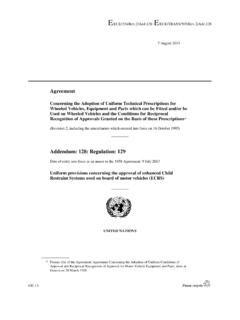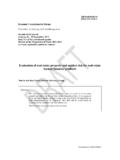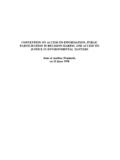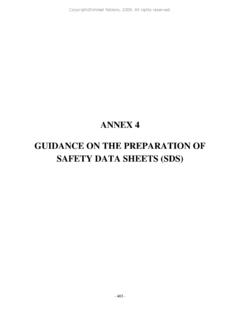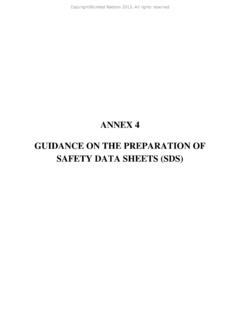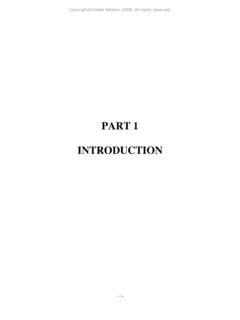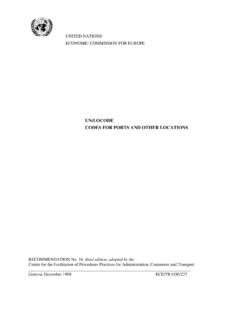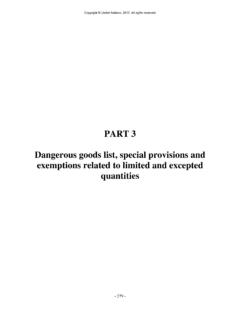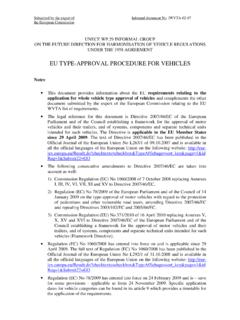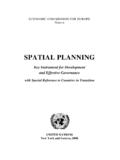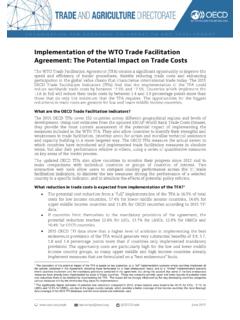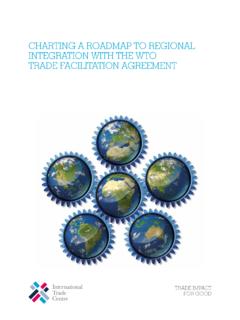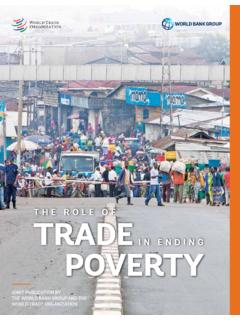Transcription of Trade Facilitation and Paperless Trade …
1 Trade Facilitation and Paperless Trade Implementation UNECE Regional Report 2017 i United Nations Economic Commission for Europe Trade Facilitation and Paperless Trade Implementation UNECE Regional Report 2017 United Nations New York and Geneva, 2017 ii Notes The designation employed and the presentation of the material in this report do not imply the expression of any opinion whatsoever on the part of the Secretariat of the United Nations concerning the legal status of any country, territory, city, or area or of its authorities, or concerning the delimitation of its frontiers or boundaries. The United Nations bears no responsibility for the availability or functioning of URLs. DISCLAIMER Opinions, figures and estimates set forth in this publication are the responsibility of the authors, and should not necessarily be considered as reflecting the views or carrying the endorsement of the United Nations. Any errors are the responsibility of the authors.
2 Mention of firm names and commercial products does not imply the endorsement of the United Nations. The report is available at: ECE/ Trade /438 Copyright United Nations 2017 All rights r es er ved wor l dwi de United Nations publication issued by the Economic Commission for Europe iii Foreword The internationalization of production and s upply chains offer developing and transition economies new opportunities to integrate into the global economy by allowing firms to join international production networks . Thus , the need for s implified Trade procedures across borders is growing for thes e countries . The Trade Facilitation agreement (TFA) one of the main outcomes of the WTO 9th Ministerial Conference in Bali in 2013 is addres s ing s uch need. According to OECD es timates , when fully implemented, the TFA is expected to reduce the total Trade cos ts of low-income countries by over 14%. Experience shows that Trade Facilitation reforms improve a country s Trade competitivenes s and enhance its revenue collection.
3 What is more, they can help advance development goals s uch as s trengthening governance and formalizing the informal s ector. In light of the entry into force of the TFA in February 2017, the res ults of the Global Trade Facilitation and Paperless Trade Survey are timely. They allow policymakers to streamline their priorities and learn from each other s experiences. The United Nations Regional Commis s ions , in partners hip with other key United Nations Organizations , have committed to s upporting member States in implementing the WTO TFA. This report is part of that commi tment and the policy recommendations and technical s tandards developed by UNECE and UN/CEFACT are key implementation tools not only for the UNECE region, but als o for other regions acros s the world. The second UNECE Report on Trade Facilitation and Paperless Trade s heds light on the TFA implementation in North American, European and Central As ian countries , identifies bes t practices, and encourages better cooperation.
4 I hope that Government officials and private sector actors involved in Trade Facilitation reform efforts will benefit from it. This report aims to help UNEC E member States to advance Trade Facilitation and Paperless Trade to the advantage of governments , cros s-border traders and cons umers, to enhance regional and global integration and to ultimately better achieve the Sustainable Development Goals of the United Nations Agenda 2030. Olga Algayerova Executive Secretary United Nations Economic Commis s ion for Europe iv Contents Foreword .. iii List of Tables .. v List of Figures .. v Li s t of Boxe s .. v Abbreviations .. vi Acknowledgments .. vii CHAPTER 1 1 Background and objective .. 1 Report instrument and methodology .. 3 Utilization of report and the data .. 6 CHAPTER 2 IMPLEMENTATION OF Trade FACILTIATION MEASURES: AN OVERVIEW .. 7 Implementation of Trade Facilitation measures and GDP per capita .. 7 Level of Implementation of Trade Facilitation Measures.
5 9 I mpl e me ntation of Trade Facilitation in the UNECE 10 Most and least implemented Trade Facilitation measures .. 13 CHAPTER 3 IMPLEMENTATION OF Trade Facilitation MEASURES: A CLOSER LOOK .. 15 15 Formalities .. 16 Institutional arrangement .. 18 Paperless Trade .. 20 Cross-border Paperless Trade .. 22 Transit 24 Trade Facilitation and 26 CHAPTER 4 CONCLUSIONS AND WAY FORWARD .. 28 Annex 1 Definitions of the various stages of implementation .. 33 Annex 2 Countries covered i n the survey ( 2017 and 2015) .. 34 References .. 35 v List of Tables Table 1. Intraregional and extraregional comprehensive Trade costs in regions (excluding tariff costs), 2010 2015 .. 2 Table 2: Trade Facilitation measures used for calculating the results .. 4 Table 3: Most and least implemented measures within each group of Trade Facilitation measures in the UNECE re gi on ( 2017) .. 14 List of Figures Figure Trade Facilitation implementation and GDP per capita of UNECE member States.
6 7 Figure Overall implementation of Trade Facilitation measures in UNECE member 9 Figure Trade Facilitation implementation in the subregions and landlocked developing countries, 2017 .. 10 Figure Implementation of groups of Trade Facilitation measures: UNECE 13 Figure Implementation of Transparency in the UNECE Region, 15 Figure State of implementation of Transparency measures (2017) .. 16 Figure Implementation of Formalities in the UNECE subregions (2017) .. 17 Fi gure State of i mpl ementation of Formal itie s ( 2017) .. 18 Figure Implementation of Institutional arrangement in the UNECE subregions (2017) .. 19 F i g u re State of implementation of Institutional arrangement (2017) .. 20 Figure Implementation of ' Paperless Trade ' in the UNECE Sub Re gions 2017 .. 21 Figure State of Implementation of Paperless Trade Measures 2017 (in %) .. 22 Figure Implementation of Cross-border Paperless Trade in the UNECE Region (2017) .. 23 Figure State of implementation of Cross-border Paperless Trade measures (2017).
7 24 Figure Implementation of Transit Facilitation in the UNECE subregions (2017) .. 25 Fi gure State of i mple me ntati on of Transi t Facili tation me asure s ( 2017) .. 26 Figure Trade Facilitation implementation and Trade costs .. 28 Figure : Moving up the Trade Facilitation ladder towards seamless international supply 32 List of Boxes Box 1 A three-step approach for data collection and validation .. 6 Box 2 Trade Facilitation reforms in the Former Yugoslav Republic of 8 Box 3 Paperless Trade in Belarus .. 11 Box 4 Evolution in Central Asia .. 12 vi Abbreviations ECA Economic Commis s ion for Africa ECLAC Economic Commission for Latin America and the Caribbean ESCAP Economic and Social Commission for Asia and the Pacific ESCWA Economic and Social Commission for Western Asia EU European Union FTA Free Trade agreement GDP Gros s Domes tic Product LLDCs Landlocked Developing Countries OECD Organization for Economic Cooperation and Development SMEs Small and Medium-sized Enterpris es TF Trade Facilitation TFA Trade Facilitation agreement UNECE United Nations Economic Commis s ion for Europe UN/CEFACT United Nations Centre for Trade Facilitation and Electronic Business UNRC United Nations Regional Commissions WTO World Trade Organization vii Acknowledgments The second Global Trade Facilitation and Paperless Trade Survey was jointly conducted by the five United Nations Regional Commissions, which include.
8 The Economic Commission for Africa (ECA), the Economic Commission for Europe (UNECE), the Economic and Social Commission for Asia and the Pacific (ESCAP), the Economic Commission for Latin America and the Caribbean (ECLAC) and the Economic and Social Commission for Western Asia (ESCWA). The initiative was led and coordinated by ESCAP. Da ta col l ecti on grea tl y fa ci lita ted by the Uni ted Na ti ons Centre for Tra de Fa ci l ita ti on and Electronic Business (UN/CEFACT), an intergovernmental body serviced by UNECE; and the United Nations Network of Experts for Paperless Trade and Transport in Asia and the Pacific (UNNExT), a knowledge community supported by ESCAP and UNECE. Comments and suggestions received from participants at the UN Regional Commissions side event to the 6th Global Review on Aid for Trade (Geneva, 12 July 2017), where the preliminary findings from the global s ur vey wer e pr es ented, a r e gr a teful l y a c knowl edged.
9 Data analysis and preparation of the 2017 Regional UNECE Report were carried out by Maria-Ter es a Pi sa ni, Khan Salehin, Deepali Fernandez and Tatiana Rosu under the supervision of Maria Ceccarelli. The Report was edited by Karina van den Linden and publishing support was provided by Am lia Delle Foglie. Support from the following organizations and individuals is gratefully acknowledged: Mario Apostolov and Julian Fraga from UNECE, Bismark Sitorus from the United Nations Conference on Trade and Development (UNCTAD) , Mohammad Saeed from the International Trade Centre (ITC), Evdokia Moise from the Organization for Economic Cooperation and Development (OECD), Dinara Sekerbaeva and Aleksei Bondarenko from the Eurasian Economic Commi ssi on (EEC). 1 CHAPTER 1 INTRODUCTION Background and objective Facilitating Trade is about streamlining and simplifying international Trade , particularly import and export procedures , trans it requirements and procedures applied by Cus toms and othe r agencies (UNECE-UN/CEFACT).
10 With the rapid increase of international Trade , thanks in part to the reduction of tariffs and quotas , it has become evident that for countries to benefit from open global markets it is neces s ary to addres s the pres s ing challenge of outdated, compl ex and inefficient Trade procedures . Although Trade Facilitation is not a novel is s ue, the recent entry into force of the WTO Trade Facilitation agreement (February 2017) has brought it to the heart of the regional and global Trade agenda. There is s trong evidence that by s implifying and modernizing Trade procedures , countries can become more competitive and increase their overall Trade flows, resulting in higher state revenue and other s ocio-economic benefits of increas ed Trade s uch as job creation, poverty reduction, and improved quality of life (OECD, 2014). Reducing Trade costs is particularly important to developing and trans ition economies, for them to acces s international production networks and effectively us e Trade as an engine of growth and s us tainable development.
